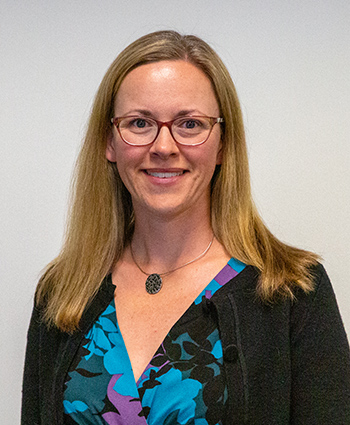Q&A with Jennifer Daw: Working at the Crossroads of Energy, Water, and Land

Balancing the needs of energy, water and land/ food systems is increasingly important due to the combined pressures from changes brought about by population growth, urbanization, and other factors. We talked with one of its experts, Jennifer Daw, a senior researcher and group manager within NREL’s Integrated Application Center.
In less than a decade at NREL, Daw has witnessed her background in water systems sustainability become more relevant than ever, as governments and businesses look for ways to integrate, co-optimize, and develop sustainable solutions for their energy, water and land systems. An edited version of our conversation follows.
How did you land at the Integrated Applications Center?
My background is unique for NREL, I came from the water and wastewater sector—a civil and environmental engineer by training. Since joining NREL in 2010, the energy-water-land nexus has become a much more important topic both domestically and globally. My work over the years has changed to accommodate this trend, and I’m finding more and more that my water background is increasingly relevant to NREL’s work.
What is the energy-water-land nexus?
The idea behind the nexus is that there’s a connection between energy, water, land use (food). And there are tradeoffs. The development choices we make affect all three systems. Traditionally the energy, water, and land sectors work in silos, singularly focused on the needs of their systems. The nexus emphasizes cross-sectoral solutions, where we look for synergies and co-benefits by viewing problems more holistically considering their impacts on social, environmental, and economic factors. NREL approaches the nexus from the perspective of energy—looking at how energy is used in water systems, what tradeoffs exist in developing land for energy versus food production, how to reduce water requirements for power generation, etc.
I enjoy this work because it’s an intersection of fields. When working in the water sector I would observe a lot of missed opportunities to save energy and cost, integrate renewable energy sources, and reduce impacts on land areas as this systems level of thinking was not in their purview at the time. With growing factors such as extreme events, resource shortages, population growth, and aging infrastructure, the water and wastewater sector is making a more concerted effort to consider the energy, water and land related tradeoffs from their operations.
What would be some examples of this work?
One way we address the nexus is through co-optimization of energy and water systems. NREL has been using the REopt techno-economic decision support model to help external partners evaluate how water treatment and storage systems can be leveraged for economic savings through demand reduction and time-of-use shifting.
NREL has also partnered with Colorado School of Mines to perform first-of-its-kind research of a water treatment system in the ESIF. In this work we studied the ability of a membrane desalination system to operate on 100% renewable energy using hardware in the loop. As membranes do best with consistent operations, the research findings were exciting as they showed that the desalination system was able to meet water quality requirements without adverse effects to the membranes running on variable renewable energy. This work sets a precedent for further research and piloting of renewable energy powered desalination systems with Bureau of Reclamation.
While our nexus work often focuses on two of the three sectors (e.g. energy and water) we are continuing to grow into more comprehensive assessments. A great example is NREL’s low-impact solar development work, which colocates agriculture with solar panels. These sites have the potential to improve soil health, retain water, nurture native species, produce food, and provide even lower-cost energy to local communities. These systems can even be taken a step further to integrate rainwater collection. I came across one such example while doing work in St. Eustatius in the Dutch Caribbean, where they had mounted gutters to the PV array to capture the intense tropical rains. This water was sent to a cistern and used to irrigate community agriculture beneath the PV array. This not only provided a resilient solution for the island to reduce its reliance on diesel fuel imports, but also addressed their reliance on imported food.
What’s your outlook for the future of this domain?
I’m optimistic—there’s a lot of potential, and we’re starting to get the right folks to talk to each other. Because the nexus inherently cuts across sectors it is challenging to understand the full picture of development decisions, which is why new models, tools, and decision strategies are needed. We are also seeing positive change due to the growing focus on resilience, which often encompasses energy, water, and land systems. NREL is continuing to engage with all sectors to better understand the challenges they are facing and to help inform solutions that will help our partners meet their current needs without compromising the needs of future generations. This is what motivates me about this work, that by using a systems approach we are making positive, long lasting change.
Last Updated May 28, 2025
